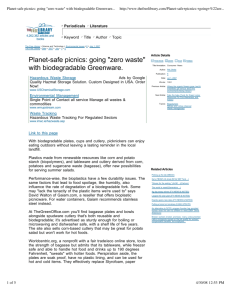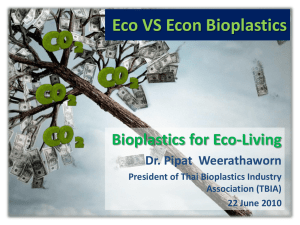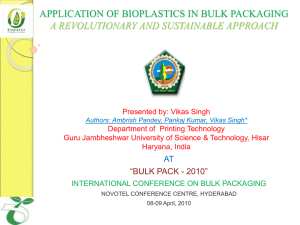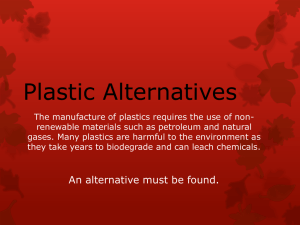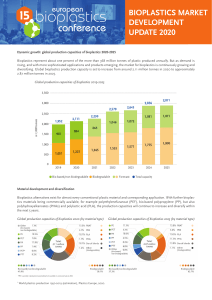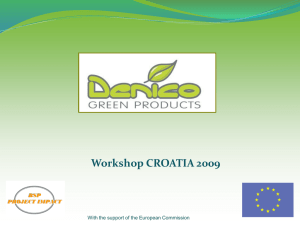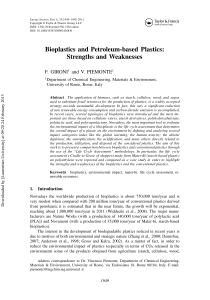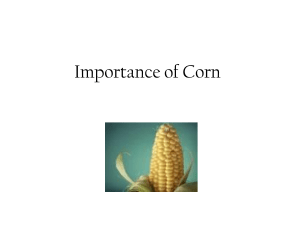Global Trends in Bioplastics
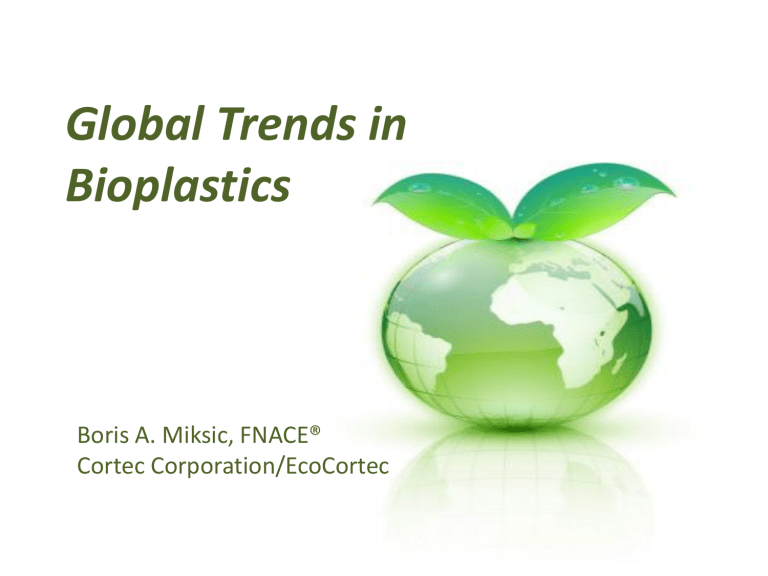
Global Trends in
Bioplastics
Boris A. Miksic, FNACE®
Cortec Corporation/EcoCortec
Overview
• Bioplastics –terminology
• Bioplastics market – trends
• Disposal
• Certification
• Conclusion
“Traditional” plastic
• Almost entirely derived from nonrenewable, fossil sources
• These are artificial materials and nature does not know how to handle them
Problem
… is all around us!
4
What does plastic waste pollution look like?
Coast of Dubrovnik/Croatia polluted by plastic materials discarded at sea, 2009
Recycling and energy efficiency - statistics
• The term "bioplastics" refers to a biodegradable plastics and/or plastics derived from renewable resources (the definition from European Bioplastics)
• Interest in bio-materials has increased significantly due to concerns related to global climate change.
Bioplastic
Plastics: 265 M tons (2010) – Plastics Europe
Bioplastics: 0.724 M tons biodegradable (non renewable resources) 428 000 t plastics from renewable resources 296 000 t
Source/base: renewable or not renewable
Material: biodegradable or not biodegradable
Development of bioplastics through history
Renewable sources - nonbiodegradable
• Historically, plastic was made from renewable resources / there was no petrochemical industry
1869. nitrocellulose – Hyatt billiard balls
1897. galalith –first Zagreb’s gramophone panel manufactured by Penkala
• Today : bio-polyethylene
What is biodegradable plastic?
• Biodegradation is degradation caused by biological activity, especially activity of the enzymes
Biodegradable plastics
Considering the source/base we distinguish:
• natural polymers (PHA)
• modified natural polymers
(viscose, methyl cellulose)
• synthetic polymers (PLA,polyesters)
What is compostable plastic?
Compostable plastic is one that meets all scientifically recognized standards of compostabilty regardless of the origin of carbon.
European norm is EN 13432, and USA norm is
ASTM D6400
ASTM D6400 – Main Factors
• 1. Mineralization
• 90 percent conversion to carbon dioxide, water and biomass through the action of microorganisms
• The same rate of degradation as other organic waste (ie. leaves, grass ...)
• Time period of 180 days or less
• 2. Fragmentation
• Not more than 10% of the original dry weight of test material shall fail to pass through a 2 mm fraction sieve.
• 3. The impact on the environment
• No negative impact on flora and fauna
Biodegradable vs. compostable?
• Compostable plastic is a subset of biodegradable plastic that will decompose in the conditions and time frames during composting process
• Compostable plastic is always biodegradable
• Biodegradable plastic is not always compostable
What is bio-based plastic ?
• Can be natural polymer or synthetic plastic made from organic macromolecules that are derived from biological resources
• To be classified as a bio-based material it must be of organic origin and contain a certain percentage of new carbon derived from biological resources
• This definition is the base of ASTM D6866
U
Comparison of plastic and steel manufacturing through history
Bioplastic market
Development of bioplastic market main drivers
• Technical properties and functionality is selling
• High consumer acceptance (eco marketing)
• Organic recycling is a cost-efficient, new recycling option
Bioplastics in Europe ( purpose)
Trenutno stanje
Market share of bioplastics by application use in 2011.
World production capacity of bioplastics by material type in 2011
Production capacities of bioplastics in the world in 2011.
and forecast by 2015.
Production capacities of bioplastics in the world by 2015.
The share of bioplastics in the global plastics market will record substantial growth in the following years
(planned annual growth of 44%)
Trendovi
Disposal
Methods of disposal after use of bioplastics
Ideal closed circle
• Renewable raw materials for plastics.
• Organic Recycling (Composting) - new option.
• CO
2
Recycling - for climate protection.
Developing Global Legislation Around Biobased Plastics
Italy - first country in the world that banned the use of polyethylene bags (January 1,2011)
Certification
Proces of certification
• Variety of different materials
• What kind of criteria do we need?
• Certification as an instrument of market competition
We have a defined system of certification for biodegradability and compostability of materials.
Certification
• Certification - procedure by which a third party gives written assurance that a product, process or service conforms to specified requirements (EN 45020:2006 standardization and related activities)
• Well-defined process in which a certification organization confirms the property of a plastic material, intermediate or product.
• Biodegradable plastics is not easy to distinguish from nondegradable plastics.
• Other ways of labelling are required in order for bioplastics to be used and disposed properly.
What Is Fueling The Growth of
Bioplastics?
Petroleum supplies are dwindling while demand for oil-based goods is rising
For every 4 barrels of oil used, only 1 new barrel is discovered.
Petrochemical-based plastics consume about 2.5 billion barrels of oil annually.
Supplies will run short within the next 20 to 100 years.
• Governments and consumers are demanding action to reduce dependence on oil.
• Increasing concerns over global warming, environmental pollution, toxic affects of some residual monomers and additives are driving legislation and consumer “backlash” against conventional plastics
More about the benefits of bioplastics..
• Reduces dependence on fossil raw materials
• The concept of biorefinery-regional economy that has a source in bio-mass
• Programs of Corporate Social Resposibility (CSR)
• In the long run - economic perspective
Conventional plastics will record high increase in prices
(50-80% in 2 years)
Bioplastics- enormous potential for savings
Not If…But When
“It took 125 years to use the first trillion barrels of oil.
We’ll use the next trillion in
30 years.
So, why should you care?”
-Chevron Ad
UNIVERSITY OF ZAGREB
FACULTY OF MECHANICAL ENGINEERING AND NAVAL ARCHITECTURE
BORIS MIKSIC
EFFECT OF EXTRUSION PARAMETERS ON PERFORMANCE
CHARACTERISTICS OF BIODEGRADABLE FILMS
DOCTORAL THESIS
Supervisor:
Dr. Sc. Mladen Sercer, professor
Zagreb, 2012.

